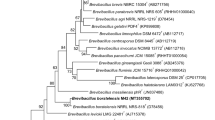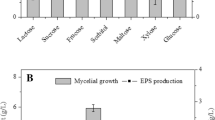Abstract
Many marine microorganisms can secrete exopolysaccharides (EPSs) which have important applications in biotechnology. We have purified a novel EPS from deep-sea bacterium Zunongwangia profunda SM-A87, identified its glycosyl composition and linkage, and optimized its production to 8.9 g/l in previous studies. To reduce the fermentation cost, an economical fermentation medium containing 60.9 % whey, 10 g/l soybean meal, and 2.9 % NaCl was developed. The EPS yield of batch fermentation in this medium reached 12.1 ± 0.3 g/l. Fed-batch fermentation was conducted and led to an EPS yield of 17.2 ± 0.4 g/l, which represents the highest EPS yield ever reported for a marine bacterium. The EPS was extracted and it displayed good rheological properties, moisture-retention ability, and antioxidant activity. Particularly, its moisture-retention ability is superior to that of other marine bacterial EPSs reported to date. SM-A87 EPS also showed high antioxidant activity. These results suggest that SM-A87 EPS has promising potentials in biotechnology.






Similar content being viewed by others
References
Antón J, Meseguer I, Rodriguez-Valera F (1988) Production of an extracellular polysaccharide by Haloferax mediterranei. Appl Environ Microbiol 54(10):2381–2386
Becker A, Katzen F, Pühler A, Ielpi L (1998) Xanthan gum biosynthesis and application: a biochemical/genetic perspective. Appl Microbiol Biotechnol 50(2):145–152
Bozzi L, Milas M, Rinaudo M (1996a) Characterization and solution properties of a new exopolysaccharide excreted by the bacterium Alteromonas sp. strain 1644. Int J Biol Macromol 18(1):9–17
Bozzi L, Milas M, Rinaudo M (1996b) Solution and gel rheology of a new polysaccharide excreted by the bacterium Alteromonas sp. strain 1644. Int J Biol Macromol 18(1):83–91
Braca A, Sortino C, Politi M, Morelli I, Mendez J (2002) Antioxidant activity of flavonoids from Licania licaniaeflora. J Ethnopharmacol 79(3):379–381. doi:10.1016/S0378-8741(01)00413-5
Buchholz FL, Peppas NA (1994) Superabsorbent polymers: science and technology. American Chemical Society
Chen L, Du Y, Wu H, Xiao L (2002) Relationship between molecular structure and moisture‐retention ability of carboxymethyl chitin and chitosan. J Appl Polym Sci 83(6):1233–1241
Chen L, Du Y, Zeng X (2003) Relationships between the molecular structure and moisture-absorption and moisture-retention abilities of carboxymethyl chitosan. II. Effect of degree of deacetylation and carboxymethylation. Carbohydr Res 338(4):333–340
Chong BF, Blank LM, McLaughlin R, Nielsen LK (2005) Microbial hyaluronic acid production. Appl Microbiol Biotechnol 66(4):341–351
DuBois M, Gilles KA, Hamilton JK, Rebers PA, Smith F (1956) Colorimetric method for determination of sugars and related substances. Anal Chem 28(3):350–356. doi:10.1021/ac60111a017
Fialho AM, Martins LO, Donval M-L, Leitão JH, Ridout MJ, Jay AJ, Morris VJ, Sá-Correia I (1999) Structures and properties of gellan polymers produced by Sphingomonas paucimobilis ATCC 31461 from lactose compared with those produced from glucose and from cheese whey. Appl Environ Microbiol 65(6):2485–2491
Gao C, Wang Z, Su T, Zhang J, Yang X (2012) Optimisation of exopolysaccharide production by Gomphidius rutilus and its antioxidant activities in vitro. Carbohydr Polym 87(3):2299–2305
Guezennec JG, Pignet P, Raguenes G, Deslandes E, Lijour Y, Gentric E (1994) Preliminary chemical characterization of unusual eubacterial exopolysaccharides of deep-sea origin. Carbohydr Polym 24(4):287–294. doi:10.1016/0144-8617(94)90073-6
Guimarães PMR, Teixeira JA, Domingues L (2010) Fermentation of lactose to bio-ethanol by yeasts as part of integrated solutions for the valorisation of cheese whey. Biotechnol Adv 28(3):375–384
Halliwell B, Gutteridge JMC (1999) Free radicals in biology and medicine, vol 3. Oxford University Press, Oxford
Kardošová A, Machová E (2006) Antioxidant activity of medicinal plant polysaccharides. Fitoterapia 77(5):367–373
Kim SJ, Han D, Moon KD, Rhee JS (1995) Measurement of superoxide dismutase-like activity of natural antioxidants. Biosci Biotechnol Biochem 59(5):822–826
Kim HM, Paik S, Ra KS, Koo KB, Yun JW, Choi JW (2006) Enhanced production of exopolysaccharides by fed-batch culture of Ganoderma resinaceum DG-6556. J Microbiol (Seoul, Korea) 44(2):233
Kurane R, Nohata Y (2002) Microbial high-functional biopolymer. J Biosci Bioeng 93(4):440
Lee HK, Chun J, Moon EY, Ko S-H, Lee D-S, Lee HS, Bae KS (2001) Hahella chejuensis gen. nov., sp. nov., an extracellular-polysaccharide-producing marine bacterium. Int J Syst Evol Microbiol 51(2):661–666
Leung PH, Zhao S, Ho KP, Wu JY (2009) Chemical properties and antioxidant activity of exopolysaccharides from mycelial culture of Cordyceps sinensis fungus Cs-HK1. Food Chem 114(4):1251–1256
Li WW, Zhou WZ, Zhang YZ, Wang J, Zhu XB (2008) Flocculation behavior and mechanism of an exopolysaccharide from the deep-sea psychrophilic bacterium Pseudoalteromonas sp. SM9913. Bioresour Technol 99(15):6893–6899
Li H-p, W-g H, Y-z Z (2011) Rheological properties of aqueous solution of new exopolysaccharide secreted by a deep-sea mesophilic bacterium. Carbohydr Polym 84(3):1117–1125. doi:10.1016/j.carbpol.2010.12.072
Lima LFO, Habu S, Gern JC, Nascimento BM, Parada J-L, Noseda MD, Goncalves AG, Nisha VR, Pandey A, Soccol VT (2008) Production and characterization of the exopolysaccharides produced by Agaricus brasiliensis in submerged fermentation. Appl Biochem Biotechnol 151(2–3):283–294
Liu L, Liu Y, Li J, Du G, Chen J (2011a) Microbial production of hyaluronic acid: current state, challenges, and perspectives. Microb Cell Factories 10(1):1–9
Liu SB, Qiao LP, He HL, Zhang Q, Chen XL, Zhou WZ, Zhou BC, Zhang YZ (2011b) Optimization of fermentation conditions and rheological properties of exopolysaccharide produced by deep-sea bacterium Zunongwangia profunda SM-A87. PLoS One 6(11):e26825. doi:10.1371/journal.pone.0026825
Nichols CAM, Guezennec J, Bowman JP (2005) Bacterial exopolysaccharides from extreme marine environments with special consideration of the southern ocean, sea ice, and deep-sea hydrothermal vents: a review. Mar Biotechnol 7(4):253–271
Pasanphan W, Buettner GR, Chirachanchai S (2010) Chitosan gallate as a novel potential polysaccharide antioxidant: an EPR study. Carbohydr Res 345(1):132–140
Poli A, Anzelmo G, Nicolaus B (2010) Bacterial exopolysaccharides from extreme marine habitats: production, characterization and biological activities. Mar Drugs 8(6):1779–1802
Prazeres AR, Carvalho F, Rivas J, Patanita M, Dôres J (2013) Pretreated cheese whey wastewater management by agricultural reuse: chemical characterization and response of tomato plants Lycopersicon esculentum Mill. under salinity conditions. Sci Total Environ 463:943–951
Qin QL, Zhao DL, Wang J, Chen XL, Dang HY, Li TG, Zhang YZ, Gao PJ (2007) Wangia profunda gen. nov., sp. nov., a novel marine bacterium of the family Flavobacteriaceae isolated from southern Okinawa Trough deep‐sea sediment. FEMS Microbiol Lett 271(1):53–58
Rougeaux H, Pichon R, Kervarec N, Raguenes GHC, Guezennec JG (1996) Novel bacterial exopolysaccharides from deep-sea hydrothermal vents. Carbohydr Polym 31(4):237–242
Sathiyanarayanan G, Seghal Kiran G, Selvin J (2013) Synthesis of silver nanoparticles by polysaccharide bioflocculant produced from marine Bacillus subtilis MSBN17. Colloids Surf B: Biointerfaces 102:13–20
Sato H, Takahashi T, Ide H, Fukushima T, Tabata M, Sekine F, Kobayashi K, Negishi M, Niwa Y (1988) Antioxidant activity of synovial fluid, hyaluronic acid, and two subcomponents of hyaluronic acid. Synovial fluid scavenging effect is enhanced in rheumatoid arthritis patients. Arthritis Rheum 31(1):63–71. doi:10.1002/art.1780310110
Selbmann L, Onofri S, Fenice M, Federici F, Petruccioli M (2002) Production and structural characterization of the exopolysaccharide of the Antarctic fungus Phoma herbarum CCFEE 5080. Res Microbiol 153(9):585–592
Su H-N, Chen Z-H, Liu S-B, Qiao L-P, Chen X-L, He H-L, Zhao X, Zhou B-C, Zhang Y-Z (2012) Characterization of bacterial polysaccharide capsules and detection in the presence of deliquescent water by atomic force microscopy. Appl Environ Microbiol 78(9):3476–3479
Wang J, Zhang Q, Zhang Z, Li Z (2008) Antioxidant activity of sulfated polysaccharide fractions extracted from Laminaria japonica. Int J Biol Macromol 42(2):127–132. doi:10.1016/j.ijbiomac.2007.10.003
Weiner RM (1997) Biopolymers from marine prokaryotes. Trends Biotechnol 15(10):390–394
Yan H, Cai B, Cheng Y, Guo G, Li D, Yao X, Ni X, Phillips GO, Fang Y, Jiang F (2012) Mechanism of lowering water activity of konjac glucomannan and its derivatives. Food Hydrocoll 26(2):383–388
Zall RR (1992) Sources and composition of whey and permeate. In: Zadow JG (ed) Whey and lactose processing. Springer, Netherlands, pp 1–72
Zhao L, Fan F, Wang P, Jiang X (2013) Culture medium optimization of a new bacterial extracellular polysaccharide with excellent moisture retention activity. Appl Microbiol Biotechnol 97(7):2841–2850
Zhou W, Wang J, Shen B, Hou W, Zhang Y (2009) Biosorption of copper(II) and cadmium(II) by a novel exopolysaccharide secreted from deep-sea mesophilic bacterium. Colloids Surf B: Biointerfaces 72(2):295–302. doi:10.1016/j.colsurfb.2009.04.018
Acknowledgments
This work was supported by the National Natural Science Foundation of China (grants 31290231, 31025001, 91228210, 31170055, 31270117, and 81271896), the Hi-Tech Research and Development Program of China (grants 2011AA090703, 2012AA092103, and 2012AA092105), and the China Ocean Mineral Resources R & D Association (COMRA) Special Foundation (grants DY125-15-T-05 and DY125-15-R-03).
Conflict of interest
The authors have no conflict of interest.
Author information
Authors and Affiliations
Corresponding author
Rights and permissions
About this article
Cite this article
Sun, ML., Liu, SB., Qiao, LP. et al. A novel exopolysaccharide from deep-sea bacterium Zunongwangia profunda SM-A87: low-cost fermentation, moisture retention, and antioxidant activities. Appl Microbiol Biotechnol 98, 7437–7445 (2014). https://doi.org/10.1007/s00253-014-5839-8
Received:
Revised:
Accepted:
Published:
Issue Date:
DOI: https://doi.org/10.1007/s00253-014-5839-8




